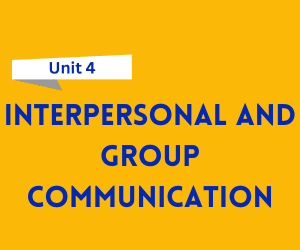In the world of business, the ability to speak clearly, confidently, and persuasively can make all the difference. Oral communication is not just about talking — it’s about connecting with your audience, making them understand your message, and inspiring them to act. This unit covers the techniques of oral communication, presentation skills, meeting management, and interview preparation.

Download UNIT 4 – Oral Communication and Presentation Skills Notes
Get simplified revision notes for this unit:
Download Unit 4 Notes PDF
1. Public Speaking: The Art of Captivating an Audience
Public speaking is one of the most essential skills for professionals. Whether addressing a small team or a large conference, a good speaker:
Understands their audience’s needs
Organizes thoughts in a logical order
Uses tone, body language, and pauses effectively
For example, a marketing manager pitching a new product must speak with enthusiasm and maintain eye contact to gain trust. Overcoming nervousness, practicing regularly, and preparing content in advance are keys to mastering public speaking.
2. Planning and Delivering Presentations
A good presentation is planned like a story — with a clear beginning, middle, and end.
Opening: Capture attention with a quote, question, or interesting fact.
Body: Present your main points supported by data, visuals, and examples.
Closing: Summarize and give a strong takeaway.
Tips for effective delivery:
Use visual aids (slides, charts, videos) to make ideas clear.
Speak at a comfortable pace.
Engage the audience with questions or interactive elements.
For example, while presenting quarterly sales results, using colorful bar charts and real-life customer stories makes the content more memorable.
3. Conducting Meetings: Notice, Agenda, and Minutes
Meetings are an essential part of business communication — but without structure, they waste time. Three important tools help keep meetings productive:
Notice: Official intimation to participants about the meeting.
Agenda: A list of topics to be discussed, arranged in order of importance.
Minutes: A written record of what was discussed and decided.
For example, in a company board meeting, the agenda may include financial updates, new project proposals, and HR policies. The minutes will document decisions like budget approvals or hiring plans.
4. Preparing for Interviews
Interviews are two-way conversations where both employer and candidate assess each other. Types of interviews include:
Personal Interview: One-to-one interaction.
Panel Interview: Multiple interviewers assessing the candidate.
Group Discussion/Interview: Candidates are tested in a group setting.
To prepare effectively:
Research the company and role.
Practice common questions.
Dress professionally and arrive on time.
Maintain positive body language and listen actively.
For instance, if applying for a sales executive role, be ready to explain how you would handle a difficult customer.
